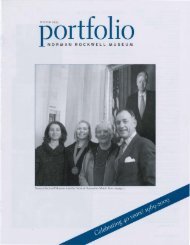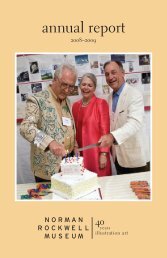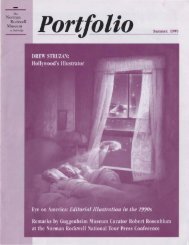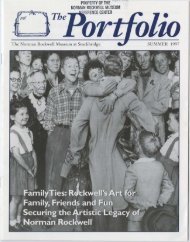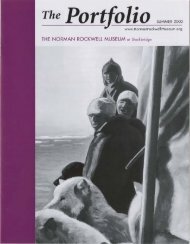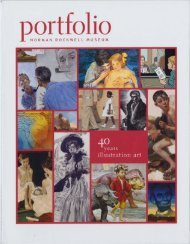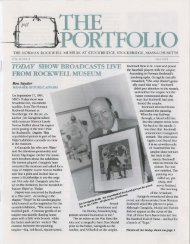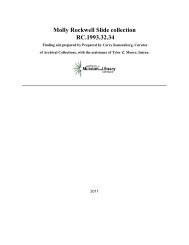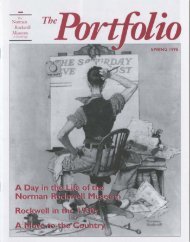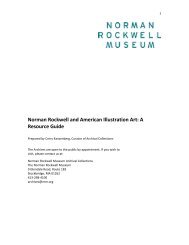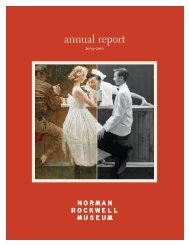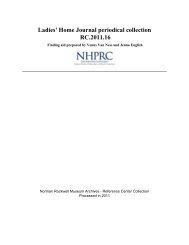The Saturday Evening Post - Norman Rockwell Museum
The Saturday Evening Post - Norman Rockwell Museum
The Saturday Evening Post - Norman Rockwell Museum
You also want an ePaper? Increase the reach of your titles
YUMPU automatically turns print PDFs into web optimized ePapers that Google loves.
nism," and in Time magazine, RobertHughes wrote, "<strong>Rockwell</strong> never madean impression on the history of art andnever will."In November, <strong>Norman</strong> <strong>Rockwell</strong>:Pictures for the American People opensin Atlanta, Georgia. This seven-venuetouring exhibition will featureseventy original works and all 322of <strong>Rockwell</strong>'s <strong>Saturday</strong> <strong>Evening</strong> <strong>Post</strong>covers. This will be the first majortraveling exhibition since <strong>Norman</strong><strong>Rockwell</strong>'s death in 1978. It will, overa two-year period, invite discussionsthat explore and reexamine <strong>Rockwell</strong>as a force in 20th-century Americanart and culture. In fact, the exhibitionwill serve to continue the vigorouscontemporary conversation thatalready has begun by known figuresin the art world and critics who arere(lecting on and reexaminingUpdike; "<strong>Rockwell</strong>'sillustration is ...excellence and cliche,"notes <strong>The</strong> New YorkTimes Book Review artdirector Steven Heller.<strong>The</strong> Washington <strong>Post</strong>'sPaul Richard urges,"He's an Americanmaster-seriously"and Paul Johnsonnotes in the LondonSpectator, "His workis beginning to strikepermanent roots.<strong>Rockwell</strong> will beranked among theOld Masters."Art historian Robert Rosenblum,taken with the "mimetic magic" in<strong>Rockwell</strong>'s paintings, reflects, "I'd<strong>Rockwell</strong>'s role in American art. been taught to snicker at him ... butI'm happy now to love him for his"... corny but cherished," says reviewer own sake. In order to enjoyGrace Glueck; "... widely loved like no <strong>Rockwell</strong>'s unique genius, all youother American painter," writes John have to do is relax."Going and Coming, oil 011 canvas, <strong>The</strong> <strong>Saturday</strong> <strong>Evening</strong> <strong>Post</strong>,August 30,1947, covel:Members of the art world are catchingup with what the American peoplehave known all along. What a peoplepleasingrevelation!Pictures for the American Peopleopens November 6, 1999 at the High<strong>Museum</strong> of Art in Atlanta, Georgia.1@1Copyright ~ 1942 by the <strong>Norman</strong> <strong>Rockwell</strong> Family Tru$t. All rights reserved.Aunt Ella Takes a Trip,oil on canvas, LadiesHomeJournal, April1942, story illustration.This story illustration isone of the almost 400<strong>Rockwell</strong> illustrations 011view in the national tOlHingexhibition <strong>Norman</strong><strong>Rockwell</strong>: Pictures forthe American People.3
THE CATALOGUE<strong>Norman</strong> <strong>Rockwell</strong>:Pictures for the American PeopleMaureen Hart Hennessey, Chief Curator<strong>Norman</strong> <strong>Rockwell</strong>: Pictures for the American People begins its seven museum tour onNovember 6, 1999 at the High <strong>Museum</strong> of Art in Atlanta, Georgia. Accompanying theexhibition is a 200-page companion catalogue of the same name. <strong>The</strong> most comprehensivevolume to date about this icon-maker and visual storyteller, <strong>Norman</strong> <strong>Rockwell</strong>: Picturesfor the American People catalogue is an important addition to any <strong>Rockwell</strong> fan's library.<strong>The</strong> quality of the <strong>Rockwell</strong> images are one highlight of thecatalogue. Here, eighty of <strong>Rockwell</strong>'s most beloved paintingsare included in full color. Original paintings from privatecollections, rarely seen in <strong>Rockwell</strong> publications, are featured,in addition to favorites from the museum's own collectionsuch as Triple Self-Portrait, Marriage License and Girlat Mirror. Full-page details present a new way of looking atseveral popular images. Archival photographs provide aglimpse of the illustrator himself.<strong>The</strong> directors and co-curatorsinvited writers from a broadrange of disciplines and perspec- 1tives to contribute essays to the ;;catalogue. <strong>The</strong> resulting volume :.tfeatures a wide variety of view- ~points. Fourteen authors shared ~. ~their own unique approaches to "'"<strong>Rockwell</strong>, and their commentsoffer a fresh appreciation of hiswork, a deep understanding ofthe complexi ty of his picturesand a reassessment of his placeboth as a shaper of mass mediaimagery and within the Americanart canon.1.~ul §~@1JGirl at Mirror, oil on canvas, <strong>The</strong> <strong>Saturday</strong> <strong>Evening</strong><strong>Post</strong> covel; March 6, 1954.Thomas Hoving, former director of the Metropolitan<strong>Museum</strong> of Art, New York, sounds the call for a reappraisalof <strong>Rockwell</strong>. Noted art historian and curator at the SolomonR. Guggenheim <strong>Museum</strong> Robert Rosenblum places<strong>Rockwell</strong> within the larger context of twentieth-century art.Karal Ann Marling, Professor of Art History and AmericanStudies at the University of Minnesota, explores the originsand evolution of <strong>Rockwell</strong>'s Christmas imagery. A personalresponse to <strong>Rockwell</strong>'s urban scenes is offered by NeilHarris, acclaimed historian ofpopular culture at the Universityof Chicago. Dr. Robert Coles,Professor of Psychiatry at HarvardMedical School and the artist'sfriend, eloquently describes thereaction by both black and whiteSoutherners to <strong>Rockwell</strong>'s historiccivil rights painting <strong>The</strong> ProblemWe All Live With.An incisive analysiS of <strong>Rockwell</strong>'s<strong>The</strong> Connoisseur is contributed byWanda M. Corn, noted historianof American art. Steven Heller, artdirector of <strong>The</strong> New York TimesBook Review and author ofnumerous books on illustration,4
After the Prom, oil on canvas, <strong>The</strong> <strong>Saturday</strong><strong>Evening</strong> <strong>Post</strong>, May 25, 1957, cove r:discusses <strong>Rockwell</strong>'s place in thedevelopment of American illustrationsince the 1950s. Professor of ArtCriticism and <strong>The</strong>ory at the Universityof Nevada and well-known critic ofcontemporary culture Dave Hickeybrings a refreshingly original interpretationto some of the artist's mostbeloved images-notably After theProm-and portrays <strong>Rockwell</strong> as aprogressive artist. Peter <strong>Rockwell</strong>,sculptor and son of the artist, revealshow certain paintings reflect hisfather's musing on his role as a artistand illustrator.<strong>The</strong> catalogue begins with essays by thedirectors of the two organizing museums.Ned Rifkin of the High <strong>Museum</strong>of Art presents <strong>Rockwell</strong> as one of thepreeminent forces in American popularculture, while Laurie Norton Moffatt,-Director of the <strong>Norman</strong> <strong>Rockwell</strong>rII<strong>Museum</strong>, reflects on the art establishment'schanging views toward<strong>Rockwell</strong>. <strong>The</strong> exhibition's co-curatorscontribute three essays: Judy L. Larson,Executive Director of the Art <strong>Museum</strong>of Western Virginia, and this writer,Maureen Hart Hennessey, Chief Curatorof the <strong>Norman</strong> <strong>Rockwell</strong> <strong>Museum</strong>,collaborated on a biographical essay;Anne Knutson, Guest Curator at theHigh <strong>Museum</strong>, examines <strong>Rockwell</strong>'srelationship to <strong>The</strong> <strong>Saturday</strong> <strong>Evening</strong><strong>Post</strong> and the influence of the magazineupon the artist and vice versa; and thiswriter also looks at the creation of<strong>Rockwell</strong>'s Four Freedoms and theirmeaning today.This first comprehensive analysis of<strong>Norman</strong> <strong>Rockwell</strong> and his workincludes the most current methodsof visual analysis and cultural historythat examine his critical role in influencingAmerican perceptions oftwentieth-century culture. Published bythe High <strong>Museum</strong> of Art and the<strong>Norman</strong> <strong>Rockwell</strong> <strong>Museum</strong> atStockbridge and distributed by HarryN. Abrams, <strong>Norman</strong> <strong>Rockwell</strong>: Picturesfor the American People has beenchosen as a Book of the Month clubselection, a rare honor for an exhibitioncatalogue. For those interested in<strong>Norman</strong> <strong>Rockwell</strong>, American art andtwentieth century popular culture, thisbook is a source of lasting enjoyment-- ..and value.THE CATALOGUE: PICTURES FOR THE AMERICAN PEOPLEMAY BE ORDERED AT$35.00MEMBER'S PRICE:$31.50I..--PHONE: 1-800-742-94505•
Before TV: American Culture, Illustration and <strong>The</strong> <strong>Saturday</strong>,,<strong>Evening</strong> <strong>Post</strong><strong>The</strong> <strong>Saturday</strong> <strong>Evening</strong> <strong>Post</strong>:What Americans Looked at Before TVChristopher Clarke-Hazlett, PhD., Guest Curator<strong>The</strong> 20th century has been a visual century. In the decades following 1900, images superseded the written wordas the most important form of communication in American culture. <strong>The</strong>y have remained dominant ever since.Today, we live with a constant bombardment of images from television, computers and the Internet. This nonstopavalanche of images would have been quite bewildering to Americans who lived before the advent of TV.During the first half of the 20th century, American culture thrived on a different kind of image - those foundin the illustrated magazines such as <strong>The</strong> <strong>Saturday</strong> <strong>Evening</strong> <strong>Post</strong>. <strong>The</strong>se images were predominantly the work ofAmerican illustrators, and they helped to shape and define the times in which many Americans lived.BEFORE TV: AMERICAN CULTURE,ILLUSTRATION AND THE SATURDAYEVENING POST explores theAmerican visual universe whenimages in the <strong>Post</strong> and other illustratedmagazines reached millions ofAmericans and became an essentialcomponent of pre-TV America'scommon visual vocabulary <strong>The</strong>exhibition offers more than 60 originalworks of illustration art by<strong>Norman</strong> <strong>Rockwell</strong> and many of hiscontemporaries, including J. c.Leyendecker, Stevan Dohanos,John Clymer, Charles LivingstonBull, Frederick Gruger, AntonOtto Fischer and Henry Raleigh.Also included are many high-qualitydigital reproductions of images from<strong>The</strong> <strong>Saturday</strong> <strong>Evening</strong> <strong>Post</strong>.<strong>The</strong> original art work in the exhibitionis arranged in sections thatfocus on cover illustration, storyillustration and advertising illustration.<strong>The</strong> images in each section aimto satisfy a specific visual objective.Because a <strong>Post</strong> cover illustrationcombined elements of both a storyillustration (it had a visual narrative)and advertising (it charmed thepublic into buying the <strong>Post</strong>), itserved a purpose different from anyof the other images in the magazine.Brass Merchant, oil on canvas, <strong>The</strong> <strong>Saturday</strong><strong>Evening</strong> <strong>Post</strong>, May 19, 1934 cover.Copyright @ 1934 by the Curtis Publ ishing Company. All rights reserved.6Like story illustrations, cover imagescommunicated elements of a tale invisual form, where the image embodiedthe entire story without referenceto any written text. Also, like theadvertiSing illustrations foundthroughout the <strong>Post</strong>, its cover illustrationalso served as an advertisingimage, but the product it was advertisingwas <strong>The</strong> <strong>Saturday</strong> <strong>Evening</strong> <strong>Post</strong>.Story illustrations represented abroader cross section of artistic styleand talent than the <strong>Post</strong> covers did.<strong>The</strong>y showcased the work of manyhighly talented illustrators. <strong>The</strong>story illustrator's job was to givevisual life to key moments in thework of fiction writers. Storyillustrators worked closely with themagazine's art director and craftedimages that added visual excitementto the reader's experience. Overtime, story illustrations became larger
Youth and Old Age, oil on canvas, Colgate Dental Creamadvertisement, 1924.and more colorful. By the late1940s, they also began to serve asan advertising function to enticethe reader. Illustrations increasinglydominated first-page layouts asstories vied with one another for thereaders' attention.<strong>The</strong> artists of advertising illustrationswere rarely identified. <strong>The</strong>ir artworkfilled the pages of the <strong>Post</strong> with representationsof a particular middle-classAmerican lifestyle. <strong>The</strong>se images alsopresented products and attempted topersuade readers that one brand wasbetter than another. <strong>The</strong>se productadvertisements became part of thevisual mix that readers encounteredwhen they turned the pages of the<strong>Post</strong>, and these works contributedSignificantly to the visual universethe magazine created.zines from itsearly yearsthrough the1960s. Stacks ofauthentic <strong>Post</strong>issues, available intwo comfortableperiod readingareas, are an integralpart of theexhibition.<strong>Museum</strong> guestsmay sit down andrelax with the<strong>Post</strong>, just as mil-lions of Americansused to do. When they look at themagazines, visitors will discover thatstory illustrations, advertisingimages and covers all blend togetherto create the <strong>Post</strong>'s overall visuallandscape.Visitors to Before TV can recapturethis same visual universe by examiningthe exhibition's original imagesand by looking through <strong>Post</strong> maga-During the heyday of illustratedmagazines, a Single image carriedfar more significance than does apassing image on today's TV screen.Part of this has to do with the differencebetween "reading" and"viewing." Before the 1950s,Americans obtained visual informationfrom images by reading. <strong>The</strong>ychose which images to look at anddecided how long they wouldspend with one before looking atanother. Today's viewers see manymore images, but they have surrenderedcontrol over the activity oflooking. Viewing, for its manyrewards, is essentially a passiveactivity. Our relationship to theimages we see today is fundamentallydifferent from the relationship<strong>Post</strong> readers had with the images inthe magazine.Before TV is not a nostalgic lookback at a world we have lost. Instead,it examines the roots of America'simage-intense visual culture byexploring the world of illustratedmagazines-the medium that firstbrought many different kinds of colorful,enticing, vividly appealingimages into American homes on amassive scale. <strong>The</strong> <strong>Post</strong>'s financialsuccess and cultural influence bothrested on the magazine's ability todeliver popular, attractive imagesto millions of American living rooms.Although the medium throughwhich images come into our homestoday is quite different, the rise ofimages to a position of undisputeddominance in today's visual culturebegan early in the 20th centurywith American illustration and <strong>The</strong><strong>Saturday</strong> <strong>Evening</strong> <strong>Post</strong>.<strong>The</strong> Handkerchiefs, oil all canvas, <strong>The</strong><strong>Saturday</strong> <strong>Evening</strong> <strong>Post</strong>, May 19, 1934, storyillustration.7
<strong>The</strong> <strong>Saturday</strong> <strong>Evening</strong> <strong>Post</strong>A NATIONAL FAMILY MAGAZINEMaud Ayson, Associate Director of EducationWhen the bell tolled for <strong>The</strong><strong>Saturday</strong> <strong>Evening</strong> <strong>Post</strong> ... ittolled not only for a venerablemagazine, but for a style, asystem, a regime -and forpart of America.- Atlantic Monthly, November 1969Girl Reading with Candy, Nonnan <strong>Rockwell</strong>, oil oncanvas, <strong>The</strong> <strong>Saturday</strong> <strong>Evening</strong> <strong>Post</strong>, June 27, 1925, cover.Through most of its history, <strong>The</strong> <strong>Saturday</strong> <strong>Evening</strong><strong>Post</strong> was defined as a national family magazine thatlauded the virtues of progress and the quest for the"American dream," while, at the same time, italso evoked a nostalgia for purer, simpler times.By the 1950s, the <strong>Post</strong> faced the increasingchallenges of photo journalism, special-nichepublications and the appeal of television. <strong>The</strong> magazinethat once prided itself on its outstandingillustrations, extraordinary mix of writing andlatest brand-name product advertisements foundit could no longer capture its audience's interest.In 1969, the <strong>Post</strong> called it quits after nearly seventyyears of continuous publication.8
Eye on America: Editorial Illustration in the 1990sEYE ON AMERICA:EDITORIAL ILLUSTRATION IN THE 1990sStephanie H. Plunkett, Curatar af lIIustratian ArtWithout thinking too much about it in specificterms, I was showing the America I knew and observedto others who might not have noticed.- NORMAN ROCKWELLArt is a part of its time. If we examinethe range of art from any era andgeographic location, we are able togain a greater understanding of theconcerns, values and attitudes of asociety in its time and place.Throughout the ages, contemporaryartists have acted as observers,informers and educators, revealingto the rest of us what was, or is,happening around us.Eye on America: Editorial Illustrationin the 1990s takes a fascinating lookat the events, celebrations, scandalsand personalities of this last decadeof the twentieth century through theeditorial art that appeared in mostof the news and note-worthy publicationsof our times-<strong>The</strong> New YorkTimes, <strong>The</strong> New Yorker, <strong>The</strong> AtlanticMonthly, Time, Sports Illustrated andRolling Stone. Prominent illustrators,given the daunting task of meetingdeadlines and maintaining personalexpression while fulfilling therequirements of each assignment,have helped shape public opinionand inspired us to consider theissues of our day. <strong>The</strong>ir visual narratives,offering new inSights into awide range of topics, enhanced andexpanded the written word.<strong>The</strong> exciting illustrations featured inEye on America prOvided the artistswith both a specific assignment andthe opportunity to personalize theirviewpoints. Whether the subjectmatter is the economy, our politicalsystem, child psychology or healthcare, these images make one thingBack from Chaos, Etienne Delessert,water color on pape r; <strong>The</strong> AtlanticMonthly, Marc h 1998.10clear-that expression need not bethe exclusive province of the fineartist. Creative art directors havelong understood the impact that arthas on a publication's readership,and they carefully consider a widerange of illustration perspectives,styles and techniques when determiningthe visual look of an article.What role does illustration play inthe life of a publication? Why do artdirectors often choose illustrationover photography for inclusion ineditorial pieces? Beautiful and visuallyinteresting images can stimulatea reader's interest and enter into anartistic dialogue with text. Authorand artist representative BarbaraGordon has commented, "Artists canrender a situation that does not existor would be impossible to photographbecause of lack of accessibility.Nothing is out of boundsAntarctica, the earth's core, heaven,hell and never-never land. <strong>The</strong>y useskill and imagination to convey anyplace or situation. Art can alsodepict esoteric subjects such as
My Most Difficult Diagnosis, MarcRosenthal, water color and ink 0 11 paper;Hippocrates, ]anuQly 1999.truth, fear, civilization, loyalty orhonesty through the use of symbolsand mood." Lush pictorial spreadscan appear at surprising momentsand, integrated with small spot illustrations,carry a reader through along piece of writing. <strong>The</strong> juxtaposi-Illustration creates themoment, unlike thephotograph which justcaptures it.tion of contrasting illustration andwriting styles also can be effective,such as the placement of humorous,playful art within a dense, academicarticle to make the reader feel morecomfortable with the piece.Renowned for her creative use ofillustration in a magazine, AtlanticMonthly art director Judy Garlanbelieves that, "<strong>The</strong> true heroes arethe illustrators. <strong>The</strong> best art asksyou to climb to a new peak whereyou get a clearer view of something.<strong>The</strong> illustrator helps you make theascent. Illustration creates themoment, unlike the photographwhich just captures it. "Consider some of the major issuesof today: Can scientists unlock thefountain of youth? Is therea hidden side to the Clinton economy?What are the implications ofcloning? Who are the most importantpoliticians, celebrities andsports figures in the news? It is theillustrators such as those included inthe exhibition Eye on America workingin a range of styles from photorealist to humorous who, using theirintelligence and talents, help coverthese important stories by addingvisual impact to the written word.Expression throughmedia creates somethingpermanent forall to see andremember. Thisexhibition showcasesalmost seventyoriginal works bytwenty-four celebratedcontemporaryillustrators. Join usfor this lively andhistoric review ofour decade throughthe art of an extraordinarygroup ofillustrators. <strong>The</strong>irimages help us toreflect upon thepast, consider thepresent and speculateon what maylie ahead.11<strong>The</strong> artists featured in the exhibitionare Marshall Arisman, N.Ascencios, Barry Blitt, JulietteBorda, Braldt BraIds, Steve Brodner,Joe Ciardiello, Tom Curry, EtienneDelessert, Robert Grossman, MarkHess, Brad Holland, Frances Jetter,Anita Kunz, Matt Mahurin, JamesMcMullan, Tim O'Brien, RobertAndrew Parker, Lynn Pauley, MarcRosenthal, Elwood Smith, EdwardSorel, Greg Spalenka, ThomasWoodruff.Eye on America: EditorialIllustration in the 1990s, on viewthrough January 23, 2000, willring in a new century.Letterman Unbound, Joe Ciw"didlo, water color and ink onpaper; <strong>The</strong> New Yorker, June 3, 1996.
REFERENCE CENTER ACQUISITIONSLinda Szekely, Curator of <strong>Norman</strong> <strong>Rockwell</strong> Collections<strong>The</strong> following gifts to the museum reference center are listed in the order in which theywere received during the period from December 1997 through August 1999. We are verygrateful for all these donations that help make the museum reference center a place toresearch the world of <strong>Norman</strong> <strong>Rockwell</strong> and the field of illustration. if you are consideringgiving a gift to the museum, please contact us at 413-298-4100, extension 212.Donations of first uses of <strong>Norman</strong> <strong>Rockwell</strong> artwork, photographs, letters, <strong>Norman</strong><strong>Rockwell</strong> books and books on art are always welcome. Please note that for the sake ofbrevity, NR is used in place of the name <strong>Norman</strong> <strong>Rockwell</strong>.Harriette and Martin Diamond of New Rochelle, NY:1935 Western Union Telegram and envelope illustrated by NR.Ms. Janet Wade of Kezar Falls, ME:1\'10 issues of Needlecrajt 0926 and 1929) with NR ads.Jean and Russell Bousquet of Pittsfield, MA:18 J. c. Leyendecker <strong>Saturday</strong> £tIening <strong>Post</strong> covers.Mr. Paul Ivory of Great Barrington, MA:28 slides of NR's South Street studio during the 1986studio move.Mr. Irwin Steinberg of Spring Valley, NY:34 tear sheets of J. C. Leyendecker illustrations.Mr. Stuart Ng of Los Angeles, CA:Falltas),: 11)e Golden Age of Fanlastic Illustration, <strong>The</strong> Illust1'(ltor inAmerica 1900-I960s, Frank Schoonoller Illustrator of the NorthAmerican Frontiel:Mr. Irving Lehr of Levittown, NY:A letter from NR (970).Robb Goldstein and Sang Ly Montage of Chatham, NY:Willie Was Different (inscribed).Ms. Catherine Hayhurst of Barrington, RI:~~}' Adventures CIS a ll Illustrator (Doubleday edition).Mr. William J. Farrington of West Springfield, MA:<strong>Saturday</strong> <strong>Evening</strong> <strong>Post</strong> cany bag.Elaine and Morton Kaplan of Pittsfield, MA:Berkshire Living, Winter 1967; <strong>The</strong> Satlerday <strong>Evening</strong> <strong>Post</strong>,December 14, 1963.Mr. David Aalto of West Townsend, MA:Boslol1 Herald news clip on NR's models, September 5, 1943; NR,Illustrator (inscribed 1st edition).Mrs. Clement Ogden of Stockbridge, MA:'two postcards sent by Molly and NR from Portugal (1968)and Norway (969).Laura and Chuck Lawson of New York, NY:CD Al Hirschfeld: Great El1tertainers.Grace and Mark Miller of Marlboro, NY:Collotype of <strong>The</strong> Lineman.Ms. Linda Gumble of Atlanta, GA:<strong>The</strong> Adventures of1bm Sawyer; Scouting with Daniel Boone; MyAdventlt1'es as eln Illus{1'(ltor (hardcover and paperback); A Rockzl'ellPortrait; NR Encyclopedia; NR, A Sixty Year RetrospectizJe; <strong>The</strong>Advertising World of NR; NR's People; Little Frencb Motber Good B)'e(sheet music); three <strong>Saturday</strong> Ellening <strong>Post</strong> magazines; two Top ValueStamp catalogues.12
Ms. Laurie Norton Moffatt of Stockbridge, MA:,vell'Rocbelle, Tbe Ci()' of the Huguenots (illustrated by New Rochelleillustrators); Photograph of former museum director Dmid Wood, staffmemher Barbara Perkel and Molly <strong>Rockwell</strong> in the Old Corner House,Clem Kaiischer, photographer; Three bound volumes of St. Nicholas magazines,.Ianuary1916 to June 1916 and JanualY 191" to.lune 1917 and July1917 to December 1917.Mr. Denys Wortman, Jr. of Boston, MA:Jletropo/itml 1101'ies (two copies); .Ilope), Dick and the Duke (twocopies), both volumes written and illustrated by the donor.Mr. Charles Flint of Lenox, MA:Reproduction of NR's painting for <strong>The</strong> Land of Ellcbantment.Mr. Edward Sawyer of West Stockbridge, MA:Three letters to Stuart Hel11Y from Douglas Stone in reference to ;-JR's 1963Cathedral of the Pines commission.Mr. Andy Talbot of Stockbridge, MA:One copy of the October 13, 1956 issue of lIJe <strong>Saturday</strong> <strong>Evening</strong> <strong>Post</strong>.Judge Neil Caldwell of Angleton, TX:One NR illustrated postcard for the Knights of Columbus (c. 1 918).Mr. Charles Debevoise of Pittsfield, MA:\ Famous Al1istS Schools booklet from 1965 with an introduction by NR,HOll' to Create lour First Original Oil Painting.Bea and Bob Snyder of Leesburg, VA:1\vo ~R illustrated books, Handbookfor Bo.)'s, <strong>The</strong> Bo.)' Scouts ofAmerica and "IR 1/lustrat01:Mrs. Helen Palmquist of Lincolnshire, IL:Literar}, Digest cover, December 12, 1922 and a 1924 Quaker Oatstear sheet.Member Profile<strong>The</strong> <strong>Norman</strong> <strong>Rockwell</strong> <strong>Museum</strong> is privileged to havethe good friendship and loyal support of JUDY ANDDAN MAGRATH of Fort Myers Beach, Florida.Recently, Judy and Dan contributed a generous donationof stock to the museum's endowment fund. This gift isthe first of its kind at the <strong>Norman</strong> <strong>Rockwell</strong> <strong>Museum</strong>and we are grateful for the Magrath's enthusiasm andunderstanding in preserving the legacy of <strong>Norman</strong><strong>Rockwell</strong>.Formerly of the South Hadley, Massachusetts area,the Magraths have long been fans and supporters ofthe <strong>Norman</strong> <strong>Rockwell</strong> <strong>Museum</strong>. Now retired, Danwas the owner of an office equipment and suppliesdistributor headquartered in Western Massachusetts.Judy and Dan each have three children, and a totalof nine grandchildren. <strong>The</strong> Magraths spend most oftheir summers in Maine and also travel to other partsof the world.Dan recalls that, as a child in New York during the1930s, he looked forward to his family's weekly copyof <strong>The</strong> <strong>Saturday</strong> <strong>Evening</strong> <strong>Post</strong>. "We feel that <strong>Norman</strong><strong>Rockwell</strong>'s work truly exemplifies Americana rangingfrom the serious such as the Four Freedoms andschool desegregation paintings, to the humorous suchas the doctor treating children, to the poignant likethe runaway or the marriage license applicants."Interlaken Congregational Church, Sunday SchoolLibrary of Stockbridge, MA:Art Stories: Book aile with ~ R's artwork for a Literm:), Digest cover,December 18, 1920.Mrs. Clement Ogden of Stockbridge, MA:1979 letter from Molly <strong>Rockwell</strong> to Mrs. Ogden and a note from NRto Mrs. Ogden.Jud) and Dall lvlagrath13
This past summer was filled with festivities hereat the <strong>Norman</strong> <strong>Rockwell</strong> <strong>Museum</strong>. <strong>The</strong>Pittsfield Fourth of July Parade; the CelebratingCinema gala; the opening of two exhibitions,Drew: Art of the Cinema and Hooray for RockweWsHollywood and our frequent corporate eventsgave the museum members and staff much tocelebrate. Here are some of the scenes fromour exciting ummer.Jennifer Goffman, Judy Goffman C.ut ln; Laurence ( uller andillustrator Drew Su Ilzall tn)o)'ed the success of the ga lae"cning and 11le exhibition opelling. Judy Goffman Cut leIExecutive DircctOl; American Illustrators Galley, Ncw YO/IICity curatcd alld assembled the exhibition, which was organizedand produced by ART Shows alld PIOe/ucts Co rp.Director Lauric NO! tor Moffatt Il1USt um bfll h tmJanc Fitzpatricll a/1d I11USllIm 'emb r llo,IJ [)obblllsjoi/1 ill the festivitiesOne of the benefits of membership is theopportunity to host an event at the <strong>Norman</strong><strong>Rockwell</strong> <strong>Museum</strong>. Many of our corporatemembers have held receptions here for theirfriends and colleagues.<strong>The</strong> <strong>Norman</strong> <strong>Rockwell</strong> <strong>Museum</strong>BOARD 0 1 TRUS Il:LSilobble l (lSI'Per I Peln •L e \\. lJ ,"tcven < lelhergJam~ W Irel., dRo cI Khne l hartot"P,C h', IIJ~ J u, rll"<strong>The</strong> PortfolioVolume lb, Numher 1, fall llJlJlJCrts Ra "I101ll1 l tt r"us (obb 'vI .hallt Dc)] lIerrhe P r't I" IS pL hshLJ four tlmlS lye bvhe orman ROLk\\ II Musc' • "10' khnJgen d d IS Ilt fne It.) ,11 e "'0 (SAnn F·IL " , Ick BI('wn\\ lllIam M llig rD,mld ~~ Ca"Jan (ohrJ"me, II ( unninl,ham, Jr.Michelle (,illw"Jcil an, Jane c..olupL la111
Over 700 museum members and guests filled the galleries to see theoriginal artwork of one of Hollywood's most famous artists.Director Laurie Norton Moffatt introduced illustratorand guest speaker Drew Stmzan at the members' opellingof Drew: Art of the Cinema and Hooray for<strong>Rockwell</strong>'s Hollywood.As a tic-in with our Hollywood summel; the <strong>Norman</strong> Roc/mell<strong>Museum</strong>s Fourth of July Parade featured characters from Star Warsand <strong>The</strong> Flintstones. Staff members louned their childrell for theevent. Seen here are Tira (Pebbles Flilllstone)and Ashley (BammBamm Rubble) MazzeI; James UndervvooJ Miller (Lulle Shywalker)and two adults disguised as Chewbacca alld C3POGuarding the terrace door are two importantHollywood figures who also attended theopening-Darth Vader and Chewbacca.15
<strong>Norman</strong> <strong>Rockwell</strong>'s ArtJo Ann Losinger, Director of Earned Revenue<strong>Norman</strong> <strong>Rockwell</strong> joins the ranksof Gauguin, Monet and Botticelliwith the introduction of a new andimaginative pop-up book. <strong>Norman</strong><strong>Rockwell</strong>: A Pop-Up Art Experienceguides you through places nearand dear to the artist's work. Hisstudio, replete with artifacts fromworld travel, showcases Triple SelfPortrait. A replica of <strong>Rockwell</strong>'sArlington parlor is packed withhis characters and a classroomscene recreates the painting HappyBirthday Miss Jones. In BoyPracticing Trumpet, a lad in an overstuffedchair blares away on histrumpet to the dismay of his dog.<strong>The</strong>se are but a few of <strong>Rockwell</strong>'sbest known works that becomethree dimensional in this charmingbook that is certain to please adultsas well as children of all ages.<strong>The</strong>re are scores of <strong>Rockwell</strong> treasureshidden in this work. <strong>The</strong><strong>Norman</strong> <strong>Rockwell</strong> <strong>Museum</strong> lobbyand a gallery complete the interiorsof the book. In addition, seventeenpopular <strong>Rockwell</strong> images are incorporatedin a foldout informationalbiography of <strong>Rockwell</strong>'s life.A Pop-Up Art Experience retails for$18.95. If you are a museum member,enjoy your 10% discount.<strong>Norman</strong> <strong>Rockwell</strong>: A Pop-Up Art Experience, pllhlished by Universe ill associationwith the [\Jorman Rochwcll MllSClIIll.-<strong>The</strong><strong>Norman</strong><strong>Rockwell</strong><strong>Museum</strong>at StockbridgeNON PROFIT ORGANIZATIONu.s. POSTAGEPAIDPermit No. 33STOCKBRIDGE MA 01262Stockbridge, MA 01262



